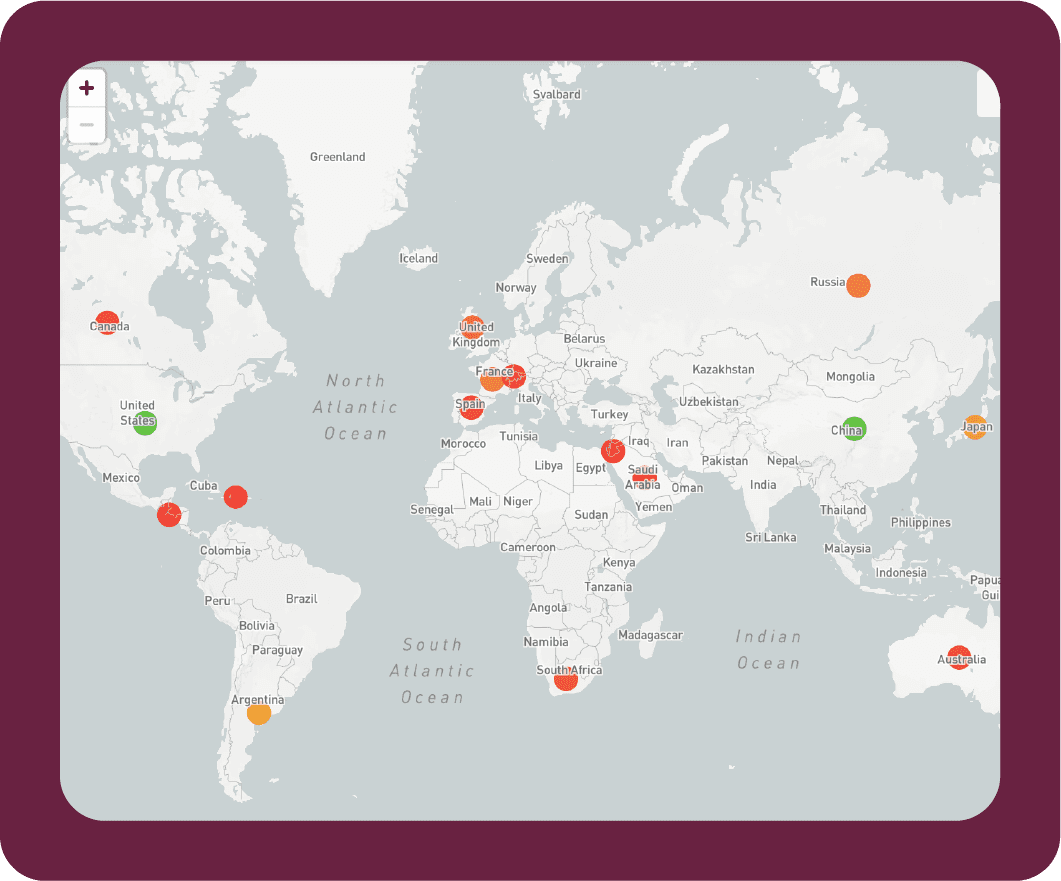Nowadays, when the average cost-per-hire exceeds $4,700 and continues to rise, traditional hiring methods are no longer sufficient to retain top talent.
Organizations worldwide are turning to talent acquisition analytics software to revolutionize their recruitment strategies and achieve measurable hiring outcomes. Companies are starting to discover that data-driven recruitment isn't just a trend, it's a necessity for sustainable growth.
The challenge facing organizations extends beyond simply filling open positions. They must navigate complex talent landscapes, understand evolving skill requirements, predict hiring difficulties, and make strategic decisions that impact long-term organizational success. This comprehensive blog explores how job analytics and advanced workforce intelligence platforms, like Horsefly Analytics, are transforming talent acquisition, enabling companies to have the insights at their fingertips to build cost-efficient, highly skilled global workforces while helping to reduce time-to-hire and understand how AI can affect their future workforce.
Throughout this article, you'll discover actionable strategies for leveraging talent acquisition analytics software, understand the critical features that drive hiring success, and learn how to implement data-driven approaches that can help eliminate guesswork from your hiring process.
According to research by SHRM, the average cost-per-hire exceeds $4,700 and continues to rise.
- Research by SHRM
Understanding Talent Acquisition Analytics Software
The Foundation of Data-Driven Recruitment
Talent acquisition analytics software represents a paradigm shift from intuition-based hiring to evidence-backed recruitment decisions. These platforms aggregate and analyze vast amounts of workforce data to provide actionable insights that can help guide aspects of your hiring process. Horsefly’s talent acquisition analytics software processes over 1 trillion data points across 65+ countries, offering unprecedented visibility into global talent markets.
Systems like this provide comprehensive labor market intelligence, including real-time supply and demand metrics, compensation benchmarking, skills gap analysis, and predictive hiring difficulty scores. This depth of data and insights enables teams to decide where to source talent, how to structure compensation packages, and when to adjust their hiring strategies.
Key Components of Effective Job Analytics
Successful talent acquisition analytics software incorporates several critical components that work together to optimize hiring outcomes:
Real-Time Market Intelligence: Platforms must provide current, validated data that reflects market conditions. Horsefly's daily data refresh ensures recruitment decisions are based on the most up-to-date market analysis, covering 170,000 towns and cities globally.
Skills and Competency Mapping: Advanced analytics platforms track millions of job titles and skills, translated by native speakers and unified across international markets. This comprehensive skill taxonomy helps identify transferable skills, alternative job titles, and emerging competency requirements.
Predictive Analytics: The most valuable talent acquisition analytics software includes predictive capabilities, forecasting favorable markets, and AI Impact for workforce transformation. These insights enable proactive recruitment planning and resource allocation.
Leveraging Job Analytics for Strategic Workforce Planning
Identifying Talent Supply and Demand Patterns
One of the most powerful applications of talent acquisition analytics software is understanding supply and demand dynamics across different markets and skill sets. Traditional recruitment approaches often rely on outdated assumptions about talent availability, leading to prolonged hiring cycles and inflated time-to-hire costs.
Modern job analytics platforms provide revolutionary features that overlay historical talent supply and demand, enabling companies to identify trends and predict optimal timing for recruitment campaigns. This longitudinal perspective helps organizations to accurately forecast when markets are most favorable for recruiting, enabling them to position themselves advantageously where competition for talent is lower.
Actionable Implementation Tips:
-
Establish Baseline Metrics: Use your talent acquisition analytics software to establish current supply and demand baselines for your key roles. Document seasonal variations and market-specific patterns that impact your recruitment success rates.
-
Create Predictive Hiring Calendars: Leverage historical data to predict when specific roles will be most challenging to fill. Plan recruitment campaigns during periods when talent supply exceeds demand to maximize your hiring success while minimizing costs.
-
Competitor Analysis: Gain real-time market insights into skills patterns, competitor analysis, and talent availability to assist you in sourcing talent for maximum recruitment ROI.

Geographic Talent Mapping and Location Strategy
Geographic diversification has become essential for building resilient talent pipelines, especially as remote work continues to reshape workforce dynamics. Talent acquisition analytics software enables sophisticated location analysis that goes beyond basic cost considerations to include talent density, skill availability, and market competitiveness.
Horsefly's global heat mapping capabilities allow recruiters to visualize talent concentration across different regions, identifying untapped markets where specific skills are abundant but underutilized. This geographic intelligence supports strategic decisions about office locations, remote work policies, and international expansion plans.
The platform's comprehensive coverage of global markets means organizations can identify cost-effective talent hubs that offer the right combination of skills, availability, and economic conditions. For example, companies seeking Software Developers might discover emerging markets with strong technical talent but lower competition from established tech companies.
Strategic Location Analysis Framework:
-
Talent Density Assessment: Use heat mapping features to identify regions with high concentrations of target skills
-
Cost-Benefit Analysis: Compare compensation requirements across different markets while factoring in local living costs
Geographic diversification has become essential for building resilient talent pipelines, especially as remote work continues to reshape workforce dynamics.
- Horsefly Analytics
Optimizing Compensation and Benefits Strategy
Market-Driven Compensation Planning
Compensation strategy significantly impacts hiring success, retention rates, and overall organizational competitiveness. Talent acquisition analytics software provides the market intelligence needed to design compensation packages that attract top talent while maintaining cost efficiency.
Horsefly's compensation analytics enable organizations to benchmark salaries against actual market rates for specific skill combinations, experience levels, and geographic locations. This granular analysis ensures that compensation offers are competitive without exceeding necessary spending thresholds.
The platform's ability to filter compensation data by gender, experience level, and skill combinations provides insights into market dynamics that impact pay equity and diversity initiatives. Organizations can identify and address potential compensation gaps while ensuring their offers remain attractive to diverse talent pools.
Compensation Optimization Strategies:
-
Skill-Based Benchmarking: Rather than relying solely on job titles, use skills-based analysis to ensure pay reflects market demand for specific competencies.
-
Geographic Adjustment Protocols: Establish systematic approaches for adjusting compensation based on local market conditions, cost of living data, and talent supply dynamics.
-
Total Rewards Analysis: Examine comprehensive employee value propositions beyond base salary, including benefits, development opportunities, and cultural factors.
Building Competitive Employee Value Propositions
Modern talent acquisition extends beyond compensation to encompass the entire employee experience. Talent acquisition analytics software helps organizations understand what they need to look at and gain insights on in order to hire more effectively.
Platforms like Horsefly provide insights into market-leading employee value proposition strategies through detailed analysis of compensation, benefits, development opportunities, and cultural factors. This intelligence helps organizations position themselves as employers of choice in competitive talent markets.
The data reveals current trends and competitive advantages that help guide evidence-based decisions about benefits packages and recruitment messaging. Organizations can identify which aspects of their employee value proposition resonate most strongly with target talent pools and adjust their positioning accordingly.
Enhancing Recruitment Efficiency Through Advanced Analytics
AI-Powered Search Optimization
Traditional recruitment methods often require extensive manual effort to identify potential qualified candidates, particularly when searching for niche skills or emerging competencies. Talent acquisition analytics software incorporates artificial intelligence to streamline and optimize the process of identifying valuable talent pools.
Horsefly's AI-powered search builder instantly analyzes job descriptions to capture both explicit and implicit skill requirements, eliminating hours of manual search string development. This technology expands talent pool options by identifying potential talent pools working under different job titles by analyzing millions of real job postings.
Predictive Hiring Difficulty Assessment
Horsefly Analytics’ Difficulty of Hire scoring system combines talent supply, demand patterns, and diversity considerations into an actionable 1-10 scale.
This enables recruitment teams to allocate resources appropriately, adjusting timelines and strategies based on anticipated challenges. Roles with higher difficulty scores receive additional attention, alternative sourcing strategies, and extended timelines to ensure successful completion.
.png?width=1060&height=880&name=Difficulty%20of%20Hire%20-%20HFE%20Page%20(1060%20x%20880%20px).png)
Addressing Skills Gaps and Future Workforce Needs
The rapid pace of technological change and evolving business requirements create ongoing challenges in identifying talent pools with the right skill combinations. Talent acquisition analytics software helps organizations expand their talent pools by identifying transferable skills and alternative industries where relevant capabilities exist.
Horsefly's comprehensive skills taxonomy enables organizations to map alternative industries and identify talent pools with experience that translates to new roles. This approach is particularly valuable for emerging positions where traditional talent pools may be limited or for organizations seeking to build diverse teams with varied backgrounds.
Preparing for AI Impact and Workforce Transformation
Integrating artificial intelligence across industries is reshaping job requirements and creating new categories of roles while eliminating others. Talent acquisition analytics software provides crucial insights into how these changes affect recruitment strategies and workforce planning.
Horsefly's AI Impact analysis feature helps organizations navigate workforce transformation by revealing how positions are evolving and which skills will matter most in the future. This intelligence enables proactive workforce planning that anticipates change rather than reacting to it.
The platform identifies which positions need immediate attention and which require long-term planning, helping organizations build resilience through targeted training programs based on real market trends rather than speculation about AI's impact.
Future Trends in Talent Acquisition Analytics
Emerging Technologies and Capabilities
The talent acquisition analytics landscape continues to evolve with advancing technologies and changing workforce dynamics. Artificial intelligence capabilities are becoming more sophisticated, enabling more accurate predictions and automated insights that reduce manual analysis requirements.
Integration of market data with predictive analytics creates opportunities for dynamic recruitment strategies that automatically adjust to changing market conditions. These capabilities will enable more responsive and efficient recruitment processes that adapt to market dynamics without manual intervention.
The expansion of remote work drives demand for more sophisticated geographic analysis capabilities that consider factors beyond traditional location-based hiring constraints. Future platforms will likely incorporate more nuanced analysis of remote work viability, team collaboration requirements, and distributed workforce management considerations.
Preparing for the Next Generation of Workforce Analytics
Organizations should begin preparing for more advanced analytical capabilities by building data literacy within their teams and establishing systematic approaches to data collection and analysis. This foundation will enable them to take advantage of emerging capabilities as they become available.
Investment in platforms that provide both current capabilities and ongoing innovation ensures that organizations can evolve their analytical sophistication over time without requiring complete system replacements. Platforms like Horsefly Analytics demonstrate this approach through regular feature releases and continuous platform enhancement.
Talent acquisition analytics software has transformed from a competitive advantage to a fundamental requirement for successful recruitment in today's complex job market.
- Horsefly Analytics
Talent Acquisition Analytics: Offering the Competitive Advantage
Talent acquisition analytics software has transformed from a competitive advantage to a fundamental requirement for successful recruitment in today's complex job market. Organizations that leverage comprehensive workforce intelligence platforms like Horsefly Analytics gain significant advantages in identifying talent, optimizing compensation strategies, predicting hiring challenges, and building diverse, high-performing teams.
The key to success lies not just in adopting these technologies but in systematically implementing data-driven approaches that align with organizational objectives and market realities. From understanding supply and demand dynamics to predicting hiring difficulties and optimizing recruitment ROI, talent acquisition analytics software provides the insights needed to make informed decisions that drive measurable hiring outcomes.
As the workforce continues to evolve with technological advancements and changing employee expectations, organizations must remain committed to continuous improvement through data-driven insights. The information and strategies outlined in this guide provide a foundation for building recruitment capabilities that adapt to changing market conditions while helping to deliver exceptional hiring results.
The investment in talent acquisition analytics software pays dividends not only in improved hiring outcomes but also in enhanced organizational agility and competitive positioning. Organizations that embrace these capabilities today will be better positioned to navigate future workforce challenges and capitalize on emerging opportunities in the global talent market.
Ready To Take The First Step?
.png?width=2000&name=Horsefly-Logo-NewTag_White%20(3).png)
